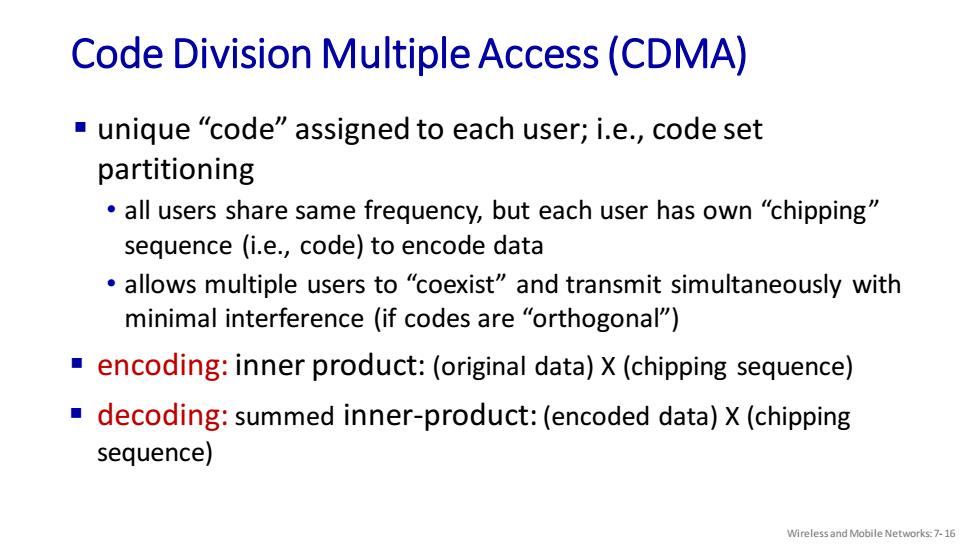
Code Division Multiple Access(CDMA) ■unique“code”assigned to each user;i.e.,code set partitioning all users share same frequency,but each user has own "chipping" sequence (i.e.,code)to encode data allows multiple users to "coexist"and transmit simultaneously with minimal interference (if codes are "orthogonal") encoding:inner product:(original data)X(chipping sequence) decoding:summed inner-product:(encoded data)X(chipping sequence) Wireless and Mobile Networks:7-16
Code Division Multiple Access (CDMA) Wireless and Mobile Networks: 7- 16 ▪ unique “code” assigned to each user; i.e., code set partitioning • all users share same frequency, but each user has own “chipping” sequence (i.e., code) to encode data • allows multiple users to “coexist” and transmit simultaneously with minimal interference (if codes are “orthogonal”) ▪ encoding: inner product: (original data) X (chipping sequence) ▪ decoding: summed inner-product: (encoded data) X (chipping sequence)
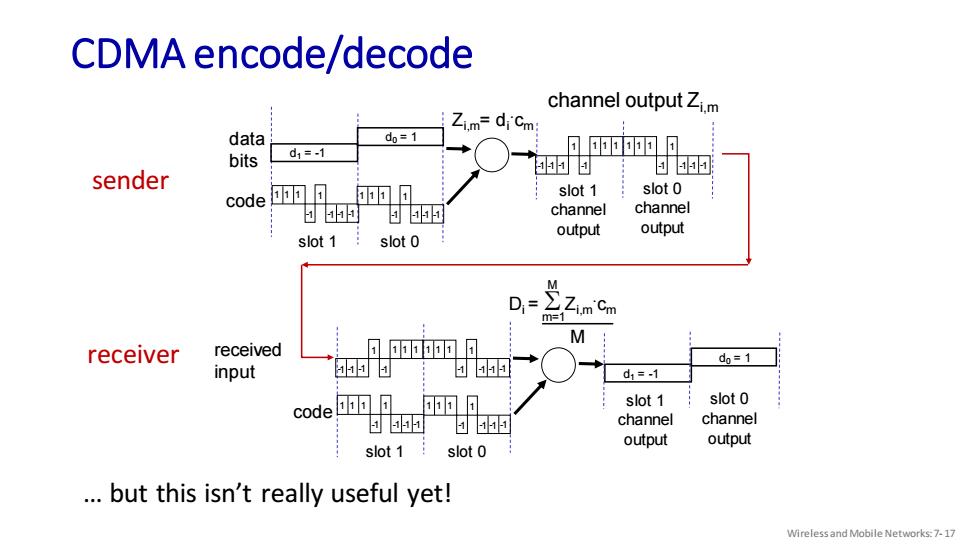
CDMA encode/decode channel output Zi.m Zi.m=diCm: data do=1 0的匝可 bits d1=-1 时 的 sender code的的日 匝 slot 1 slot 0 的甘5 channel channel output output slot 1 slot 0 M receiver received 的的可 do=1 input 5可 的 d1=1 code匝▣f 而可 slot 1 slot 0 匝 channel channel slot 1 output output slot 0 ..but this isn't really useful yet! Wireless and Mobile Networks:7-17
CDMA encode/decode Wireless and Mobile Networks: 7- 17 slot 1 slot 0 d1 = -1 1 1 1 1 -1 -1 -1 -1 Zi,m= di . cm d0 = 1 1 1 1 1 -1 -1 -1 -1 1 1 1 1 -1 -1 -1 -1 1 1 1 1 -1 -1 -1 -1 slot 0 channel output slot 1 channel output channel output Zi,m sender code data bits slot 1 slot 0 d1 = -1 d0 = 1 1 1 1 1 -1 -1 -1 -1 1 1 1 1 -1 -1 -1 -1 1 1 1 1 -1 -1 -1 -1 1 1 1 1 -1 -1 -1 -1 slot 0 channel output slot 1 channel output receiver code received input Di = S Zi,m . cm m=1 M M … but this isn’t really useful yet!
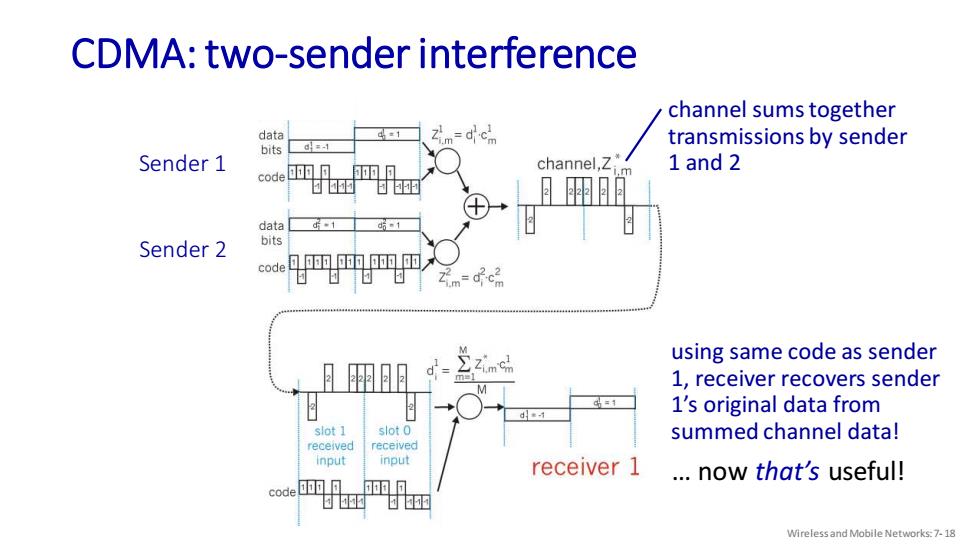
CDMA:two-sender interference channel sums together data 1 d=-1 transmissions by sender bits Sender 1 code的匝 匝可 channel,Z; 1 and 2 data d61 Sender 2 bits code四匝四匝四匝 2m=dc using same code as sender 1,receiver recovers sender C=1 d 1's original data from slot 1 slot 0 summed channel data! received received input input receiver 1 ..now that's useful! code匝 Wireless and Mobile Networks:7-18
CDMA: two-sender interference Wireless and Mobile Networks: 7- 18 using same code as sender 1, receiver recovers sender 1’s original data from summed channel data! Sender 1 Sender 2 channel sums together transmissions by sender 1 and 2 … now that’s useful!
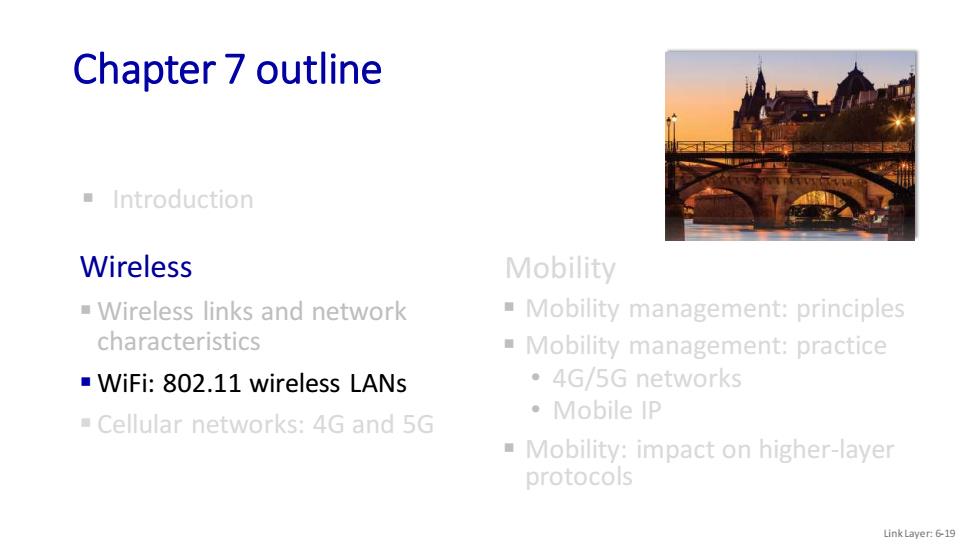
Chapter 7 outline ■Introduction Wireless Mobility Wireless links and network Mobility management:principles characteristics Mobility management:practice WiFi:802.11 wireless LANs ·4G/5 G networks 。Mobile IP Cellular networks:4G and 5G Mobility:impact on higher-layer protocols Link Layer:6-19
Chapter 7 outline ▪ Introduction Link Layer: 6-19 Wireless ▪ Wireless links and network characteristics ▪ WiFi: 802.11 wireless LANs ▪ Cellular networks: 4G and 5G Mobility ▪ Mobility management: principles ▪ Mobility management: practice • 4G/5G networks • Mobile IP ▪ Mobility: impact on higher-layer protocols
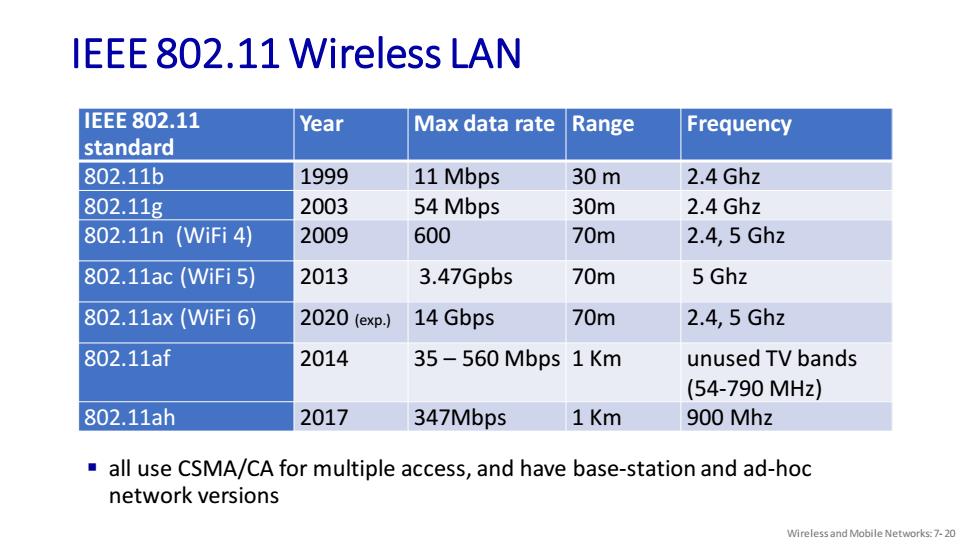
IEEE 802.11 Wireless LAN 1EEE802.11 Year Max data rate Range Frequency standard 802.11b 1999 11 Mbps 30m 2.4 Ghz 802.11g 2003 54 Mbps 30m 2.4 Ghz 802.11n(WiFi4) 2009 600 70m 2.4,5Ghz 802.11ac (WiFi 5) 2013 3.47Gpbs 70m 5Ghz 802.11ax(Wifi6) 2020(exp.) 14 Gbps 70m 2.4,5Ghz 802.11af 2014 35-560 Mbps 1 Km unused TV bands (54-790MHz) 802.11ah 2017 347Mbps 1Km 900 Mhz all use CSMA/CA for multiple access,and have base-station and ad-hoc network versions Wireless and Mobile Networks:7-20
IEEE 802.11 Wireless LAN Wireless and Mobile Networks: 7- 20 IEEE 802.11 standard Year Max data rate Range Frequency 802.11b 1999 11 Mbps 30 m 2.4 Ghz 802.11g 2003 54 Mbps 30m 2.4 Ghz 802.11n (WiFi 4) 2009 600 70m 2.4, 5 Ghz 802.11ac (WiFi 5) 2013 3.47Gpbs 70m 5 Ghz 802.11ax (WiFi 6) 2020 (exp.) 14 Gbps 70m 2.4, 5 Ghz 802.11af 2014 35 – 560 Mbps 1 Km unused TV bands (54-790 MHz) 802.11ah 2017 347Mbps 1 Km 900 Mhz ▪ all use CSMA/CA for multiple access, and have base-station and ad-hoc network versions